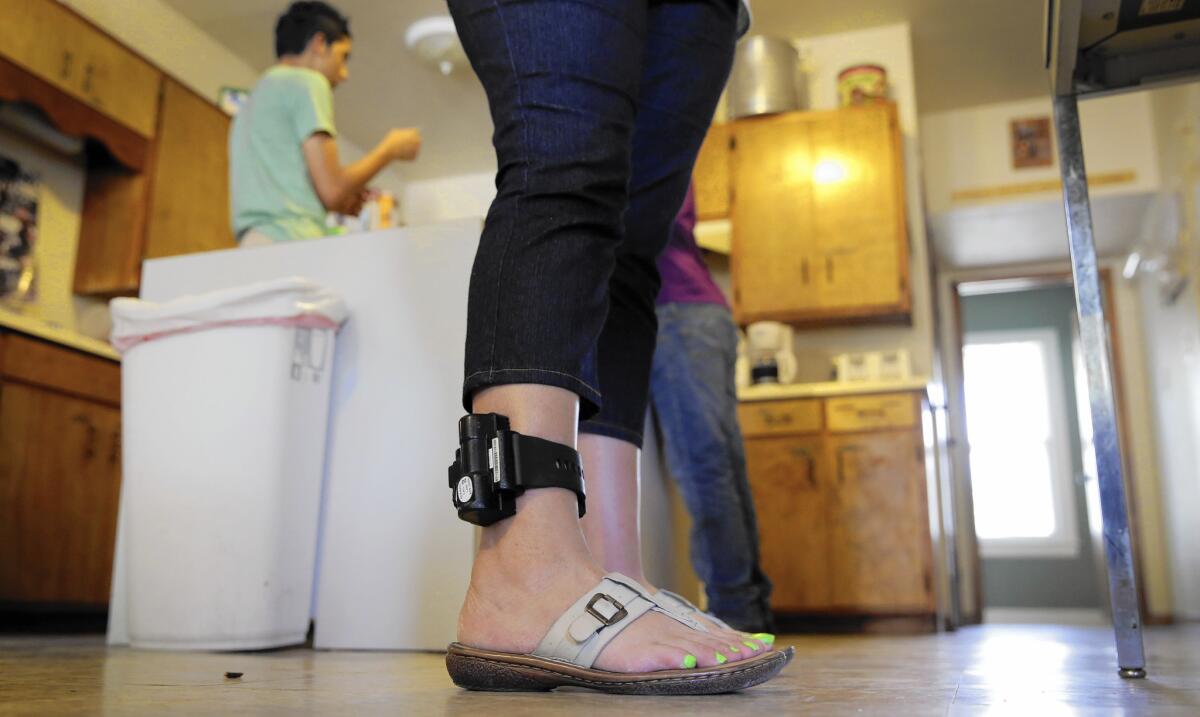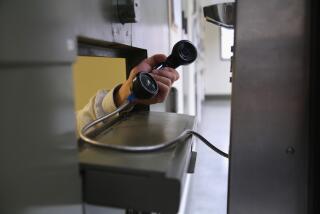Immigrants object to growing use of ankle monitors after detention

Reporting from HOUSTON — The Honduran woman and her 11-year-old son were just preparing to leave the detention center in remote Karnes City, Texas, and rejoin family in Chicago, when officials sprang a surprise on her.
After spending two months at the facility, the woman faced a U.S. Immigration and Customs Enforcement agent insisting she accept an electronic ankle monitor as a condition of her release.
“No, this is unjust. I don’t want you to put it on,” said the 32-year-old woman, who asked to be identified only by her first name, Nely, due to her pending immigration case.
------------
FOR THE RECORD:
Ankle monitoring of immigrants: In the Aug. 2 Section A, an article about immigrants who are forced to wear electronic ankle monitors as a condition of their release from U.S. detention incorrectly referred to Immigration and Customs Enforcement spokeswoman Gillian Christensen as Gillian Anderson.
------------
The official, she recalled, told her: “We give you free food, free clothing, a place to sleep. So you just need to deal with it.”
GPS ankle monitors are becoming standard equipment for immigration officials along the border. In July, Immigration and Customs Enforcement, or ICE, used about 9,300 ankle monitors at a time — 40% more than about six months ago. They are run by a government contractor, BI Inc., a subsidiary of the country’s second-largest prison company, which also operates immigration detention centers.
Officials say the monitors are a cheap and effective way to ensure that immigrants released from detention attend court hearings.
The monitors cost an average of $5 a day per person, according to an ICE spokesman, and are part of the agency’s Alternatives to Detention program, which also may require immigrants to report by phone or in person. In contrast, detention costs an average of $130 per day per person, and can cost over $330 at some detention centers.
It’s not clear how effective ankle monitors are. Last week, officials stopped releasing figures for how many immigrants wearing the devices show up in court, saying they were trying to verify data.
Immigrants, who call the monitors grilletes, or shackles, complain that they are uncomfortable, inconvenient and carry a stigma.
“They feel like a criminal,” said Sister Norma Pimentel, who runs an immigrant aid center on the Texas border, in McAllen. “They say, ‘How will I be able to work with that?’ They pray they don’t get it.”
The ankle monitors are part of the government effort to handle the surge of thousands of children and families, mostly Central Americans, who have been crossing into the U.S. for more than a year.
The U.S. went from one 95-bed immigrant family detention center in Pennsylvania to three, the two newest in Karnes City and Dilley, Texas. By year’s end, the centers will have a total of 3,700 beds.
There are now about 1,700 adults and children in family detention. As it has expanded, family detention has also increasingly come under attack by immigration lawyers, advocacy groups and lawmakers, who have pressured ICE to release more immigrants.
In June, Homeland Security chief Jeh Johnson announced several changes to family detention, including releasing on reasonable bonds and with ankle monitors family members found to have a fear of persecution in their home countries.
Johnson told the House Judiciary Committee that ICE was “ramping up” its use of ankle monitors and intended to more than double the total number monitored, from 23,000 last year to 53,000 in 2016.
Ankle monitors are not issued to those under 18, pregnant women or others with “significant medical issues.”
ICE officials say ankle monitors are used “on a case-by-case basis with a priority for detention of serious criminal offenders and other individuals who pose a significant threat to public safety. Those who are not subject to mandatory detention and don’t pose a threat to the community may be placed on some form of supervision.”
But immigrant advocates argue that many detainees are coerced into wearing them.
Last week, the CARA Pro Bono Legal Project in Dilley and other immigrant lawyers’ groups sent a letter to ICE Director Sarah Saldaña demanding the agency stop using the monitors.
In a motion also filed last week, they allege ICE officials recently summoned about 100 immigrant women in the detention center at Dilley to makeshift trailer courtrooms and urged them to sign paperwork to be released with ankle monitors in lieu of bond.
Several of the women filed affidavits saying they had been forced to accept ankle monitors. “I signed it because I am desperate to get out of here. My son has been extremely ill,” a Guatemalan woman wrote in one of the affidavits.
ICE spokeswoman Gillian Christensen says they are reviewing the claims.
----------
FOR THE RECORD
Aug. 2, 8:51 a.m.: An earlier version of this article referred to ICE spokeswoman Gillian Christensen as Gillian Anderson.
----------
Immigrants complain the devices have to be charged frequently with short cords that leave them tethered to outlets. According to ICE officials, the monitors take about two hours to charge.
Victor Cruz, 41, a taxi driver from Usulutan, El Salvador, who crossed the border into Texas with his 12-year-old daughter illegally last month, has been released with an ankle monitor.
“It bothers me — it hurts my skin and it’s hot,” he said during a stop at the church in McAllen, sheepishly lifting his right pant leg to show the bulky black device.
Andrew Free, a Nashville-based immigration attorney volunteering at the Texas detention centers, said a Honduran client fought in court for a week to not wear an ankle monitor, and had her release approved on her own recognizance — only to have ICE issue her a monitor anyway. The relative she went to stay with in Texas was hesitant to host her because of the stigma associated with the monitors, Free said.
Advocates argue that ankle monitors criminalize asylum seekers. “Electronic monitoring devices are best used for high-risk folks with criminal histories,” said Denise Gilman, director of the immigration clinic at the University of Texas at Austin’s law school, adding that studies show the monitors alienate immigrants from the court system.
Nely contended that it was illegal to force her to wear an ankle monitor since she had been released by a judge with no bail or other requirements.
After she was freed, she called her pro bono attorney and returned to immigration court, where a judge ordered the monitor removed.
It took days to get the company to take the device off, Nely said.
“It feels like they’re not operating under the law,” she said.
Instead of ankle monitors, advocates said immigrant families should be provided with legal and social services — that the government should shift from punishing to aiding asylum seekers, the way it assists refugees.
“These folks are running away from harm,” Pimentel said. “They’re not criminals.”
Twitter: @mollyhf
ALSO:
Northern California fire explodes; 24 homes lost, thousands threatened
Second American is accused of illegally killing lion in Zimbabwe
Seeking safety in Mexico City, journalist found death
More to Read
Sign up for Essential California
The most important California stories and recommendations in your inbox every morning.
You may occasionally receive promotional content from the Los Angeles Times.











